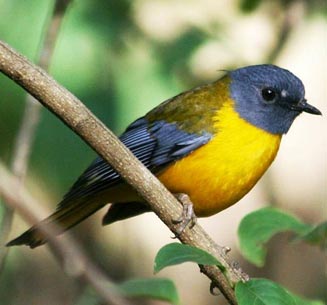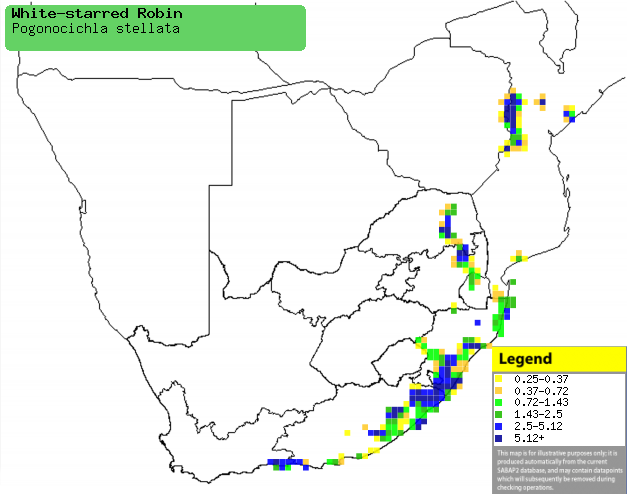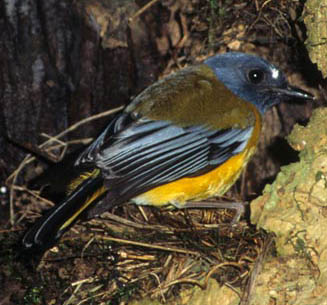|
Pogonocichla stellata (White-starred
robin, Starred robin)
Witkoljanfrederik [Afrikaans]; Sterrepaapje
[Dutch]; Rougegorge étoilé [French]; Sternrötel [German];
Pisco-estrelado [Portuguese]
Life
> Eukaryotes >
Opisthokonta
> Metazoa (animals) >
Bilateria >
Deuterostomia > Chordata >
Craniata > Vertebrata (vertebrates) > Gnathostomata (jawed
vertebrates) > Teleostomi (teleost fish) > Osteichthyes (bony fish) > Class:
Sarcopterygii (lobe-finned
fish) > Stegocephalia (terrestrial
vertebrates) > Tetrapoda
(four-legged vertebrates) > Reptiliomorpha > Amniota >
Reptilia (reptiles) >
Romeriida > Diapsida > Archosauromorpha > Archosauria >
Dinosauria
(dinosaurs) > Saurischia > Theropoda (bipedal predatory dinosaurs) >
Coelurosauria > Maniraptora > Aves
(birds) > Order: Passeriformes
> Family: Muscicapidae
 |
|
|
White-starred robin, Queen Elizabeth Park,
Pietermaritzburg, South Africa. [photo
Alan Manson
©] |
|
For information about this species, see
www.birdforum.net/opus/White-starred_Robin Distribution and habitat
Occurs in patches from the extreme south of Sudan through
Tanzania and eastern DRC to Malawi and southern Africa. Here it is locally
fairly common in the eastern half of the region, generally preferring
Afromontane evergeen forest with tangled undergrowth, although it may move into
dune forest and well-wooded gardens in forest mosaics (especially in the
non-breeding season).
|
 |
|
Distribution of White-starred robin in southern Africa,
based on statistical smoothing of the records from first SA Bird Atlas
Project (©
Animal Demography unit, University of
Cape Town; smoothing by Birgit Erni and Francesca Little). Colours range
from dark blue (most common) through to yellow (least common).
See here for the latest distribution
from the SABAP2. |
Brood parasites
It has been recorded as host of the
Red-chested cuckoo.
Movements and migrations
Altitudinal migrant, as in KwaZulu-Natal
juveniles and unpaired adults moves to lower Altitude around
March-April, heading back during September.
Food
It mainly eats insects (especially beetles) supplemented
with small fruit, which it mainly eats around April-September. It does most of
its foraging in the undergrowth and canopy, gleaning food from leaves, twigs and
bark but also hawking prey aerially and taking insects from the ground. The following food items have been recorded
in its diet:
- Animals
- insects
-
centipedes
- frogs, such as Arthroleptis xenodactyloidea
- Berries and seeds
- Hedychium flavescens (Flowering ginger)
- Ficus sycomorus (Sycomore fig)
- Xymalos monospora (Lemonwood)
- Ilex mitis (African holly)
- Kiggelaria africana (Wild-peach)
- Halleria lucida (Tree-fuchsia)
- Cassipourea gummiflua (Large-leaved onionwood)
- Cassipourea malosana (Onionwood)
- Canthium inerme (Turkey-berry)
- Rhus succedanea (alien Wax-tree)
Breeding
- The nest is built is built solely by the female in up to a week,
consisting of a domed structure, with the roof of the nest often in line
with the rim of the cup (such as in the photo to the left), although
sometimes it builds a "porch" protruding from the front of the nest (like
the photo on the right). It is usually built with dead leaves, tendrils,
rootlets and moss, with the living stems of a fern or Asparagus often
incorporated into the walls and roof. The interior is usually lined with
large, skeletonised leaves, flowers and animal hair, such as from horses and
Bushbuck (Tragephalus scriptus). It is typically placed on a slope,
often at the base of a tree trunk, well concealed by vegetation; it may also
build it against a bank, beneath a boulder or in a fallen tree trunk.
 |
 |
|
|
White-starred robin at its nest with chicks,
Entabeni, Soutpansberg, South Africa. [photo
Warwick Tarboton ©] |
White-starred robin. [photo Peter Steyn
©] |
|
- Egg-laying season is mainly from October-November, although if a clutch is
lost it may relay later, around December-January.
- It lays 2-3 eggs, which are incubated solely by the female for about
16-18 days.
- The chicks are brooded solely by the female for the first five days of
their lives, but are fed by both parents, leaving the nest after about 13-16
days, remaining dependent on their parents for about 40-42 more days.
Threats
Not threatened.
References
-
Hockey PAR, Dean WRJ and Ryan PG 2005. Roberts
- Birds of southern Africa, VIIth ed. The Trustees of the John Voelcker
Bird Book Fund, Cape Town.
-
Harrison, J.A., Allan, D.G., Underhill, L.G., Herremans, M.,
Tree. A.J., Parker, V. & Brown, C.J. (eds). 1997. The atlas of southern
African birds. Vol. 2: Passerines. BirdLife South Africa, Johannesburg.
|
